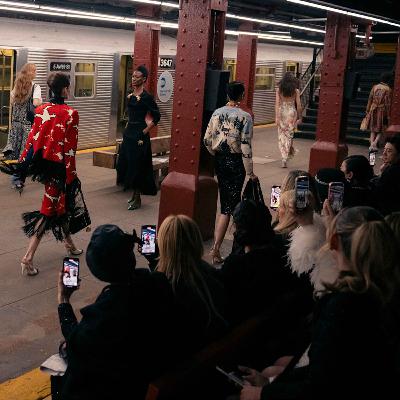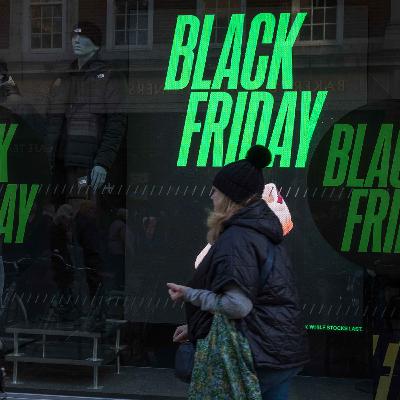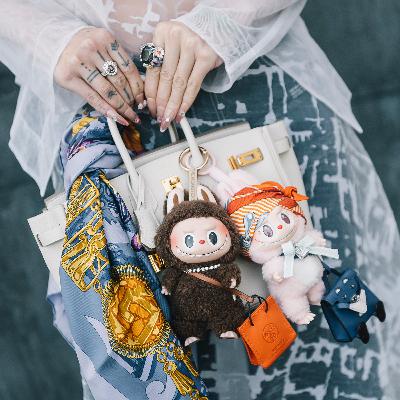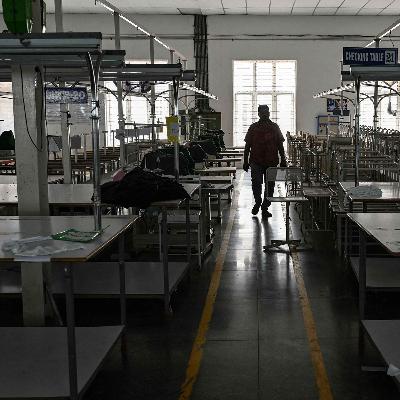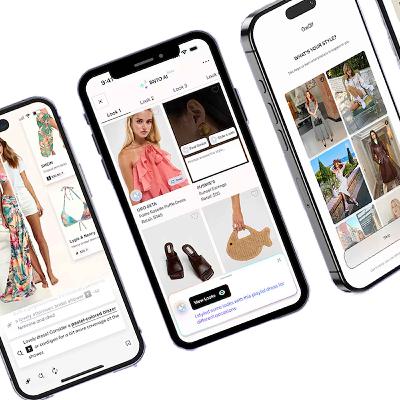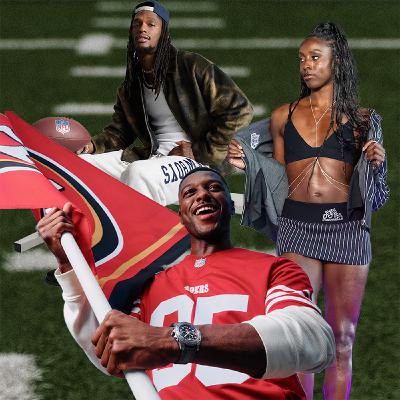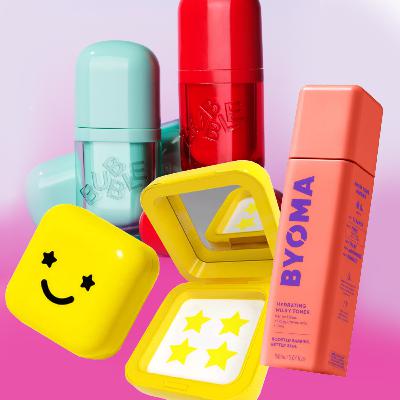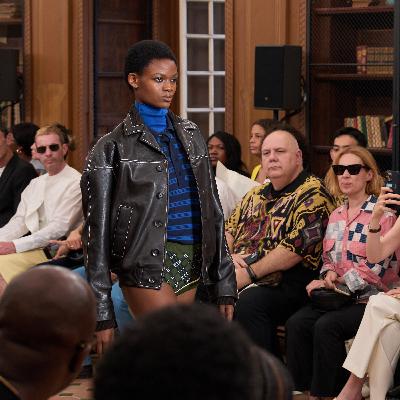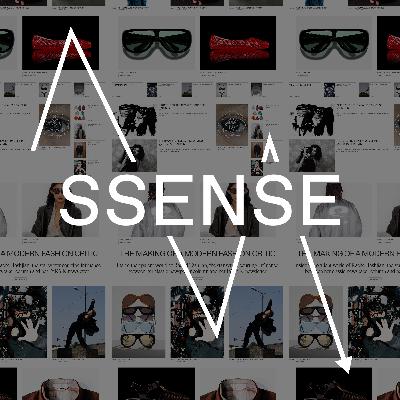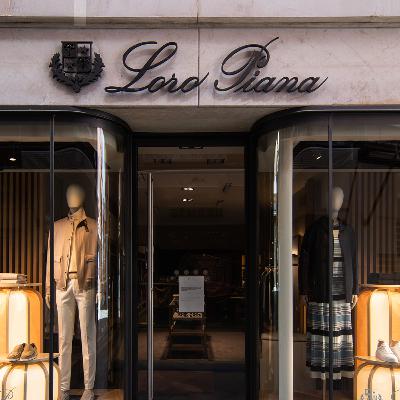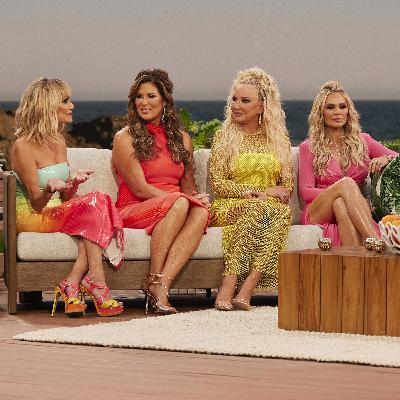Discover The Debrief
The Debrief

The Debrief
Author: The Business of Fashion
Subscribed: 85Played: 1,706Subscribe
Share
© 2022
Description
Welcome to The Debrief, a new weekly podcast from The Business of Fashion, where we go beyond the glossy veneer and unpack our most popular BoF Professional stories. Hosted by BoF correspondents Sheena Butler-Young and Brian Baskin, The Debrief will be your guide into the mega labels, indie upstarts and unforgettable personalities shaping the $2.5 trillion global fashion industry.
Hosted on Acast. See acast.com/privacy for more information.
106 Episodes
Reverse
Choosing “sneaker of the year” has rarely been this contentious. In 2025 the debate has splintered opinion between incumbent players like Nike and contenders from Vans, Converse and New Balance as consumers test the field.Whilst Nike’s shadow looms and expands with new silhouettes, real-world volume is being driven by ‘regular’ pairs like ASICS’ black-and-silver GEL-1130.In this episode of The Debrief, BoF’s Sheena Butler-Young and Brian Baskin sit down with Mike Sykes to unpack the data, the storytelling and what this year signals for 2026.Key Insights:In a widening market, this year’s debate has splintered opinions. Unlike typical years with “two to three shoes,” 2025 felt like “it’s five, it’s six, it’s seven, it’s eight,” says Sykes. He frames it as consumers testing “Nike versus the field,” with many deciding, “I’m actually gonna try the field for once,” which explains why we have seen credible contenders from Vans, Converse, New Balance and more.At the same time, reports of Nike’s demise are overdone. “Nike has always – and, in my opinion, probably will always – be the industry standard. The company is just too big at this point; it makes too much money. Even when it fails, it’s still a notch above its competition,” says Sykes. The real question now is which Nike silhouettes win attention. A few years ago it was largely Jordan 1s, 3s and Dunks, however now styles like Infinite Archives 17, Awake’s Jordan 5, and Nigel Sylvester’s Jordan 4 are all taking space.Hype is increasingly powered by storytelling that feels personal rather than driven by pure scarcity. Nigel Sylvester’s Jordan 4 showed how “over the top” yet authentic activations made fans attach to Nigel beyond the sneaker. “He’s riding his bike, kissing babies, shaking hands,” says Sykes. It’s “absolutely marketing” but designed to connect on emotion.On sneaker resale marketplace StockX, beneath the headline-grabbing premiums, Asics is moving serious volume with everyday pairs. As Mike notes, “the black and silver Asics Gel-1130 is just a common shoe that you could probably just go to your Foot Locker and buy,” yet he sees “people just buying the shoe up.” Set against hype, the GEL-1130 shows how “regular everyday shoes that look cool” can dominate real-world sales even when they’re absent from sneaker-of-the-year shortlists.Additional Resources:The Sneakers That Mattered Most in 2025The Kicks You Wear: The Collab of the Year With Bimma WilliamsThe Kicks You Wear: The Death of Sneakers Is Overstated Hosted on Acast. See acast.com/privacy for more information.
Collectively, Clare Waight Keller and Maria Cornejo have over two decades of experience in the fashion industry. Waight Keller’s impressive career includes roles at Givenchy, Chloé and Gucci — and today, she serves as creative director at Uniqlo. Cornejo’s New York–based label, founded nearly three decades ago, counts Michelle Obama and Christy Turlington Burns among its most devoted fans.From deeply entrenched gender biases to the fear of returning to work after giving birth, women face a number of systemic barriers to reaching senior leadership positions in the fashion industry, insiders say. Today, some women designers have found success launching their own labels — and when they do land leadership roles at major houses, often make it a priority to create opportunities for other women, which remain few and far between.At the VOICES 10th anniversary, Waight Keller and Cornejo speak with senior correspondent Sheena Butler-Young about what it’s like to work in an industry where women are the muses and chief customers, but the top commercial and creative roles are dominated by men. Key Insights: Clare Waight Keller says that the inequalities between men and women in fashion are driven in part by the narrative that “men are often seen as the implementers of big change, and women of stability, and so with stability we’re often also cornered into a commercial sense of aesthetic.” Both Waight Keller and Cornejo push back against this notion, saying that women aren’t less creative but simply more considerate of how real women want to dress.Maria Cornejo feels that “there’s a big disconnect in fashion… from what's instagrammable and what is actual reality … all the women I know who have independent businesses… we’re making clothes that women wear.” Both designers say they have encountered inequities as women in fashion, prompting Waight Keller to intentionally assemble an all-women team at Uniqlo. “Women add so much richness into the conversation of clothing, we offer a completely different perspective which is equally powerful and equally relevant,” she says.Additional Resources:BoF VOICES 2025: Finding Connection in Turbulent TimesClare Waight Keller | BoF 500Maria Cornejo | BoF 500 Hosted on Acast. See acast.com/privacy for more information.
Luxury’s most eventful year in some time is closing with a bang. From Prada’s Versace acquisition to Matthieu Blazy’s debut Chanel Métiers d’Art collection, seismic industry developments are landing on an almost daily basis.In this episode of The Debrief, senior correspondent Sheena Butler-Young and executive editor Brian Baskin are joined by BoF’s Luxury editor Robert Williams, who unpacks all of the industry’s most pertinent news, including the strategic implications of A$AP Rocky’s partnership with Chanel, the rise of the beaten up handbag, and the future of luxury in 2026.Key Insights: The luxury market’s forecast is cautiously optimistic, relying heavily on Chinese consumers and designer-led resets to revive the industry. Brands also need to grapple with justifying value after aggressive price increases in recent years. “Pricing’s certainly going to be an issue and it’s going to be a big issue in the US, which is a really key market for maintaining the brand’s top line,” Williams said.With Prada’s acquisition of Versace closing this week, it remains unclear as to whether the brand will continue with Dario Vitale’s new approach to Versace, or steer towards a more classic, glossy aesthetic. “[Versace] has gone through a pretty radical shift over the past couple of months and whether or not [Prada’s] going to want to continue with that is the biggest most urgent decision, and for them to clarify that for the market,” Williams said.Luxury dining is becoming increasingly popular across the world, but can luxury chains like Langosteria remain cool as they expand? “Fashion once upon a time was all made by your local tailor, your local couturier, and once they decided they could scale taste, that was more desirable than just having something that was more small-scale … In food it seems like it’s kind of the opposite,” Williams said.Originally inspired by Jane Birkin and Mary-Kate and Ashley Olsen, beaten up bags are everywhere in luxury fashion today. “There’s something about the fact that, no matter how much you wear out that bag and trash it, it’s still not going to break and fall apart. I think it just makes it a really cool style gesture. It shows you’re not someone who just bought into it yesterday,” Williams said.Additional Resources:Prada’s Versace Acquisition Closes, Now the Real Work BeginsHow Beat-Up Bags Became a Luxury Status SymbolBreaking Down Chanel’s A$AP Rocky Partnership Hosted on Acast. See acast.com/privacy for more information.
As the holiday shopping season approaches, consumer sentiment is slumping, yet spending is bifurcated – the top end keeps buying while the bottom 80 percent is more cautious. With Black Friday looming, brands are recalibrating promotions around value, desirability and hero products rather than blanket discounts. In luxury, upheaval at several department stores has created white space for rivals to woo high-spending clients through aggressive clienteling and tighter, faster vendor partnerships. In this episode of The Debrief, hosts Brian Baskin and Sheena Butler-Young speak with BoF reporters Cat Chen and Malique Morris about how brands are planning the season.Key Insights: Consumer spending hasn’t vanished, but it’s shifted toward shoppers who still feel flush. As Chen notes, “people are not really feeling rosy about the state of the economy, but the irony is that they’re still spending money.” Since Covid, “spending has been driven by the wealthier segment,” and it’s clear that “what consumers want is value… they want to get a good deal, but they don’t want to buy a cheap product.” For retailers, that means “more sophistication around price architecture” and using AI “to price products perfectly.”“Black Friday–Cyber Monday is not a fix for a mediocre year,” says Morris. Instead, winners are “prioritising desirability over discounts,” introducing “new products specifically for this time” and pushing “hero best-selling product.” The old playbook is out, and “slapping a 50% off everything discount on Instagram is not gonna cut it,” says Morris. In the “age of curation,” even deal-hunters expect editing, storytelling and reasons to stop scrolling.Morris argues that even in a discount-driven moment like Black Friday, shoppers still want offers to feel edited and intentional, and brands are responding with more curated tactics rather than blanket markdowns. “We’re in the age of curation and so even when people are expecting deals, they don’t want to feel like they’re just getting slopped,” says Morris. Tariffs and margin pressure mean many brands cannot afford a race to the bottom, pushing them to plan inventory more carefully, introduce new products specifically for this period and reserve discounts for hero items.Chen explains that this holiday season is especially high stakes for luxury multi-brand retailers because a few big players are stumbling – and everyone else is trying to capitalise. “Saks and SSENSE and Luisa Via Roma are three players that have faced pretty bad challenges this year,” she says. “They have opened up white space for their competitors on healthier financial footing to come in and basically eat their lunch and acquire their customers, acquire their sales.” The response is an aggressive push on clienteling and talent: retailers are not just targeting wealthy individuals, but also the salespeople and stylists who already manage those relationships.Additional Resources:Brands Try to Get the Tone Right for Holiday 2025 | BoF Inside Luxury Retailers’ Bare-Knuckle Fight to Win the Holidays | BoF Black Friday Beauty Goes Beyond the Discount | BoF Hosted on Acast. See acast.com/privacy for more information.
As COP30 gets underway in Belém, a port city on the edge of the Brazilian rainforest, the mood is sober. A decade after the Paris Agreement was adopted internationally to limit global warming, many of the world’s largest fashion companies have fallen short on emissions cuts — and some are moving in the wrong direction, emitting pollutants at an even higher rate than in previous years.In this episode of The Debrief, senior correspondent Sheena Butler-Young and executive editor Brian Baskin are joined by BoF reporters, Sarah Kent and Shayeza Walid, to examine why progress has stalled, how fast-fashion growth is reshaping the landscape, and what practical steps — from decarbonising supply chains to adapting factories to extreme heat — are needed next. Key Insights: Kent says, “I would not say any brand has a credible pathway right now to meet their targets for 2030,” “Even companies that have shown that they’re able to reduce their emissions to date, driving down their carbon footprint over the next five years is going to be harder, more complex and more costly… and really no one company can do that alone.”Kent highlights the industry’s deep structural bind: “The fundamental conflict at the heart of the fashion industry’s climate commitments is that you’ve got a business built on extracting stuff and producing stuff and selling stuff. The more stuff they sell, the better the business does, but the worse the environmental impact is,” “Profitability and sales growth are fundamentally at odds with the environmental commitments companies have made.”Short-term thinking still in the boardroom locks in higher climate impacts, adaptation costs and supply-chain risk. As Kent puts it, “On climate, if you don’t act, you don’t have to make these big investments, and you can keep growing your business and things will trundle along for some time. But the longer you wait to act, the worse the climate impacts you’re going to have to deal with are going to be, and the higher the cost of mitigating them, adapting to them, and trying to continue this business in a climate-constrained world.”Voluntary commitments aren’t enough at fast fashion’s scale. Walid points to Shein: “Shein’s case is very instructive. There’s limits to voluntary commitments, which is what the majority of these brands have made.” She continues, “When the business model is built on speed and volume… it just shows that voluntary commitments are maybe not enough for a fashion brand – especially a brand as big as Shein – to actually tangibly reduce its emissions when its entire business case doesn’t stand for that.”Climate impacts are now serious human and corporate risks. “It’s not just a corporate issue anymore,” says Walid. “People who have the visuals recognise the reality of what’s happening in these factories and the people who are making clothes at the end of the day.” Kent adds: “People who are suffering from heat stress are not as productive… floods are disruptive to production, to logistics, to supply chains. Just because we have not yet seen a major disruption to the apparel supply chain from these climate crises yet is more luck than anything else.”Additional Resources:Can Fashion Still Meet Its Climate Promises? | BoF The Frayed Edge: Is Fashion Quiet Quitting on Climate? | BoF Hosted on Acast. See acast.com/privacy for more information.
Colourful charms, Labubu-laden handbags and a ring on every finger – accessories sales are booming. A surge of necklace stacks, playful rings and quirky charms is being driven by Gen Z’s push for personal style, using add-ons to customise minimalist wardrobes on a budget. With apparel prices up, accessories act as “little luxuries” and entry points into brands. Retail is responding, with buyers widening small-leather-goods assortments and e-commerce shoots now styling bags with charms to encourage add-on purchases. BoF reporter Diana Pearl joins The Debrief to unpack what’s fuelling the accessory pile-on, how labels are capitalising on it, and how far the trend can go before the cycle turns. Key Insights: According to Pearl, Gen Z is reaching for accessories as a way to personalise their minimalist wardrobes. “Gen Z, which is really looking to define their sense of personal style, is leaning on accessories to do so, especially because minimalism in clothing is still very popular… but they also wanna have a little more fun and accessories are a way to do that,” she says. Regarding the longevity of this trend, Pearl adds, “I think we'll see a consumer that is primed to think of accessories as a more important part of their wardrobe – not just like a finishing touch, but a core element of it.”The Labubu craze captures the mood of the accessories trend – playful, collective and endlessly customisable. “There’s so many different Labubus. There’s a bit of that thrill of the hunt to try to find the right one. You can add it to an Hermès bag or a $100 leather tote from J. Crew,” says Pearl. For many shoppers, she says, “it really speaks to that desire for fun and adding a personal touch. People want things that make them feel good.”While luxury houses profit from entry-level add-ons, Pearl sees independent makers riding the wave. “I think it probably is helping luxury brands but I think even more than that, it’s helping small brands that really can make these cute accessories that feel distinct and different from what everyone else has, because I think a huge part of this is that quest for personal style, wanting something unique,” says Pearl. Pearl frames the moment as a behavioural shift rather than a transient trend. She argues, “trends go away, but they never fully go away. I think every trend leaves a lasting impact or impression on us. Maybe Labubus, toe rings, and bag charms won’t be quite as popular, but maybe they’ll evolve.” Crucially, “I think that this has unlocked something in people… it will have a lasting after effects of this trend, even if not everybody is wearing five necklaces at once in a year from now.”Additional Resources:How Far Can Fashion’s Accessory Obsession Go? | BoF Why Jewellery Feels Like a Better Deal Than a Handbag | BoFLuxury’s Untapped Opportunity in Men’s Jewellery | BoF Hosted on Acast. See acast.com/privacy for more information.
In late August, the US doubled duties on Indian goods to 50 percent, in what President Donald Trump described as a punishment for India’s purchases of Russian oil. Brands reacted immediately, postponing or cancelling orders and leaving factories in hubs like Tiruppur and Bengaluru half-filled. With shifts cut and workers laid off, the shock ricocheted through India’s export economy, exposing how little protection garment workers have while relief talks and trade diplomacy drag on.Senior correspondent Sheena Butler-Young and executive editor Brian Baskin are joined by BoF reporter Shayeza Walid to trace how trade policy in Washington quickly impacted the lives of India’s garment workers. Key Insights: The tariff that came into place at the end of August led some suppliers to feel “punished for something they didn’t have any hand in,” as Walid puts it. She adds: “That penalty was linked to India’s continued purchases of Russian crude oil,” and “it hit very fast because brands immediately reacted to it once the 50 percent came into place.”The disruption hit export hubs first and hardest. With brands reluctant to absorb the shock, factories have been left to “bear the brunt,” passing the pressure onto the most vulnerable link in the system. The result is workers facing furloughs, layoffs and open-ended uncertainty. “These workers are largely migrant workers who… don't have the power to collectively bargain and kind of demand what they have the right to”, says Walid. As a result, migrant garment workers are bearing the brunt through layoffs, furloughs and lost income. The response from Western brands has been silence and arm’s-length accountability, as most work through layers of sub-contractors in India. Walid says that, despite public rhetoric on labour rights, “in practice, there's not anything in place that would fix … these short-term contracts and brands not knowing where subcontracting factories are connecting with suppliers.” During Covid, watchdog pressure pushed some labels to repay cancelled orders, but “at this moment, that’s not something that we’re seeing,” Walid notes. In the meantime, a few large exporters are temporarily absorbing parts of the tariff to keep relationships alive – an approach suppliers themselves say is unsustainable – while smaller factories shut and workers absorb the shock.Beyond geopolitics, commercial terms and supply-chain opacity push risk onto workers. “It’s really the purchasing practice and the way contracts work in the supply chain. In the exporting industry, that leaves workers in this really helpless condition,” says Walid. Complexity of the system also weakens accountability: “It’s really extraordinarily difficult to get data and direct kind of causality from a particular brand,” and in hubs like Tirupur, “subcontracting factories are essentially the main suppliers to these bigger factories because they just get such large volumes.” Additional Resources:India’s Garment Workers Are Paying the Price for Trump’s Tariffs | BoF Trump’s 50% Tariff Sows Fear Inside Indian Apparel Hub | BoF Hosted on Acast. See acast.com/privacy for more information.
A new wave of AI shopping agents has emerged as Big Tech and start-ups alike vie for dominance of this new market. OpenAI, Google and Perplexity are experimenting with search-to-checkout, while fashion-specific entrants like Vêtir, Phia and Gensmo are learning users' tastes before recommending and purchasing across retailers. But before they get off the ground, trust, accuracy, privacy and simple usefulness remain open questions.Senior correspondent Sheena Butler-Young and executive editor Brian Baskin are joined by BoF reporter Malique Morris to map the agentic ecommerce landscape. Key Insights: AI shopping agents aim to move beyond static recommendations to truly act on a shopper’s behalf. As Morris explains, “traditional e-commerce has algorithms that recommend items based on what you’ve already browsed or purchased,” whereas “an AI shopping agent is supposed to learn the shopper and can act on their behalf,” handle “very specific prompts” and, ultimately, complete the transaction.Agents are trying to replicate the best in-store experience for the ecommerce space. “They’re supposed to be about replicating the in-store salesperson, surfacing the right piece based on the conversation that you might have,” says Morris. As a result, “it’s not calling for brands to rethink how they’re designing their goods,” but more about tools that “help them sell them better and help them get into the hands of the people who are actually really going to want them.”Early users are avid shoppers who love new technology. Morris doesn’t expect a sudden tipping point, but rather gradual mass adoption. “Agentic commerce is [already] here because the tools are being built and experimentation is happening,” he says. “People are going to be conditioned the same way that they were conditioned when Netflix rolled out their algorithms, the same way TikTok and Instagram have with ‘for you’ pages. It’s here, it’s happening and it’s only going to get more efficient.”While the consumer should benefit from this new suite of AI shopping agents, Morris is blunt about power dynamics: “Outside of ‘the consumer is going to win,’ I think it’s going to be who has the resources to perfect this.” Consolidation is to be expected as many smaller platforms are “probably going to get consumed into an OpenAI or a Google or an Amazon. Those already huge [players] are probably going to be the ultimate winners.”Additional Resources:What It Will Take for Consumers to Let AI Shop For Them | BoF Hosted on Acast. See acast.com/privacy for more information.
This fashion month, models walked the tightrope between fantasy and function. On the runway, spectacle was dialled up to 100: Alaïa’s armless “straitjacket” dress, Margiela’s metal mouthpieces, and Jean Paul Gaultier’s naked male body prints were among the pieces to spark a wider debate. Some critics have asked what feels like an obvious question: do designers actually understand — or even care — how women dress in their real lives?BoF’s Diana Pearl and Cat Chen join senior editor Sheena Butler-Young to examine why criticism is intensifying now, the role of authorship and how brands can balance showmanship with wearability.Key Insights: Designers face backlash when spectacle eclipses women’s realities. As Pearl observes, “designers weren’t really designing for actual women — or at worst, designing clothes that felt almost disrespectful.” To Pearl, many runway moments “felt either like it was erasing the woman or immobilising them… like fashion is a form of torture.” Even if looks are “dramatized for the runway,” she says, “there’s still a message being sent” that can be interpreted as designers not respecting women. Chen doesn’t see this season as uniquely outrageous in a vacuum, but says context matters. She adds that criticism hits harder now amid other external circumstances, one of which is that many brands are struggling financially. “The fact that these designers had a commercial incentive to be more resonant with consumers and then created these collections that didn't hit at that level, I think that made these collections so much more perceptible to be criticised in this way,” says Chen. Body diversity is the more urgent gap to fix. Pearl says the ultra-thin casting “adds insult to injury… a parade of models that are all extremely thin and… unattainable,” compounding the sense that runways aren’t made with real women in mind. Chen goes further: “the lack of body diversity on the runway is a huge problem,” noting data that shows representation “falling straight down from 2023 to 2025.”Pearl notes perception shifts with who’s in charge: “Women aren’t represented at the top, so it makes us more primed to look at a mouthpiece and feel it’s sexist because it’s coming from a male designer.” Still, she points to shows that balance both: Chanel’s debut “felt very wearable” while staging delivered “otherworldly” theatre, and Khaite’s runways pair mood with pieces that, also, “feel very wearable.” Chen adds that smaller, women-led brands win by staying close to their customer: “It’s really not about spectacle, it’s about being in the same room as their customers.”Additional Resources:Does Fashion Know What Women Want? | BoF Fashion’s Musical Chairs Ends — With Men in Almost Every Seat. | BoF The Emerging Designers Pushing Fashion Forward | BoF Hosted on Acast. See acast.com/privacy for more information.
Retailers are racing to repackage shops as “third places” — low-pressure spaces to linger between home and work — as post-pandemic footfall softens and social isolation rises. Sociologist Ray Oldenburg’s original idea centres on civic, low-barrier hubs like cafés and libraries rather than commercial destinations, yet brands are now adding seating, listening bars and in-store cafés to nudge dwell time, loyalty and favourable word of mouth. The best versions use subtle amenities that keep people comfortably in the space, but the sales impact is yet to be proven.In this episode, BoF retail editor Cat Chen joins The Debrief to unpack why scale matters, how to measure success beyond sales, and where third-place experiments risk sliding from community into pure branding.Key Insights: In their efforts to create third places, retailers are utilising food and beverage as subtle amenities that keep people lingering: it’s ‘not about creating food and beverage as a destination, but about simply getting people to spend more time in the store,’” says Chen. Done well, that “authentically [creates] a community,” and “when you have this really positive experience in their ecosystem, you will feel very positively about the brand.” Still, she cautions: “The idea of a third place as a way to drive sales for retailers is an unproven theory.”“Community building is authentic and not a branding exercise,” Chen says. The worst versions of third places feel “branded to death” and designed for photos more than social connection. “At the end of the day, it's not about the social experience of being there, it's about taking a photo of it and being able to consume this luxury brand. That's akin to the first step of being able to afford their $3,000 handbag.” It all goes back to commerce and “is very much the opposite of what Oldenburg meant.” Practical amenities in stores build goodwill. Western outfitter Tecovas’ “radical hospitality” includes a lounge and a free bar inside its store, Sephora succeeds with a hands-off approach when customers are trying samples, and Apple allows patrons to charge their phone or use the bathroom — a small service that leaves a positive halo. As Chen puts it, food and beverage in a third place should be low commitment, cheap and have a low barrier to entry. “There have been a lot of thinkpieces about private members’ clubs popping up in New York and how this is tied to this desire for third places. Private member clubs are not third places, they are the antithesis of third places." Additional Resources:Can a Store Ever Be a ‘Third Place?’ | BoF How Brands Make Community More Than a Buzzword | BoF Hosted on Acast. See acast.com/privacy for more information.
From team-branded fashion shows to tunnel-walk capsules and luxury watch deals, sport and fashion are converging at speed. The NFL has rolled smaller licensing tie-ups into marquee partnerships, while the WNBA is emerging as a fertile ground for inventive brand-player collaborations. But alongside the growth is bloat: logo-slap collections, clearance-rack remnants and fuzzy KPIs.Senior correspondent Sheena Butler-Young and executive editor Brian Baskin are joined by BoF sports correspondent Mike Sykes to map the deals that resonate and the ones that miss — and how success of these partnerships are being measured beyond the momentary halo.Key Insights: The WNBA is a collaboration engine because players are the drivers, not passengers. “I think the WNBA right now is a breeding ground for some of these deals in part because the players are eager to find these other opportunities to spread their portfolio,” Sykes says. That unlocks new formats: partnerships “not just between teams and brands or the league and brands, but players themselves and the brands [that] manifest in really cool and unique ways.”Name, Image and Likeness (NIL) has supercharged women’s sports, and fashion is part of the bargaining. Sheena points out the 2021 shift when “college athletes could not monetise their name, image, or likeness” and then stars like “Angel Reese and Caitlin Clark were becoming brands in their own right.” That changes how teams and leagues engage players: “fashion deals can be a bargaining chip on both sides of that equation.”As sports and fashion collaborations become more ubiquitous, authentic propositions are needed to cut through the noise. As Butler-Young puts it, the best examples “take the collections seriously. They treat it like a real fashion product. ‘Anything will do’ – people see through that.” Sykes agrees: “To work with players, you have to work with teams that really want to do things the right way.” It has to make sense for the consumer, and when it doesn’t, the audience calls it out. “The Chelsea and OVO collection was kind of a logo-slap. Even the fans were like, ‘This isn’t it.’” For some brands and athletes involved in these collaborations, partnerships are judged on reach and relevance rather than immediate revenue as the key marker of success. Sykes points to the NFL x Veronica Beard blazers: “There’s still some of that product left and it’s 75 to 80 per cent discounted … you have to look at that as a failure.” Yet the league “takes a holistic view,” he says: even if one capsule doesn’t sell through, lessons on “what you produce, how much, where you produce it, who your core audiences are” feed the next partnership.Additional Resources:Sports and Fashion Are Tighter Than Ever. But Who’s Really Winning? Has Fashion’s Convergence With Sports Gone Too Far? How WNBA Players Are Using Merch to Underscore Their Value Hosted on Acast. See acast.com/privacy for more information.
Brands like Bubble, Starface and Byoma rode TikTok-native aesthetics to win Gen-Z hearts and Sephora shelf space with plush mascots, playful stickers and sensorial jelly textures. Founders close in age to their audience moved fast, crowd-sourced ideas and mastered algorithms. Now the oldest Gen Z consumers are nearing 30 and looking for fewer gimmicks and more proof that formulas work.In this episode, senior beauty correspondent Daniela Morosini unpacks what still resonates, where the “dopamine” look carries a credibility tax, and why channel strategy, product performance and smart casting matter more than ever.Key Insights: Gen Z brands broke through by moving at internet speed and co-creating with their audience. “These brands are all just so digitally native… and for a lot of them the founders were quite young themselves,” says Morosini. They were “small, scrappy businesses [with] shorter product launch cycles [and] really savvy marketing.” Crucially, they “did a lot of crowdsourcing, social listening, and were really plugged into internet forums,” so products felt made with, not just for, their audience.The ‘fun’ factor worked best online as visuals drove discovery: “Goopy, gloopy, sticky things… look good in a video. You see someone put that on their face and then you want to try it.” At the same time, expectations have climbed as “people are really quick to reject a product if it doesn’t perform exactly the way they want.” And bright, playful packaging can backfire for results-seekers: “Colourful, bright things we associate with play, silliness, youth and frivolity… you might think, ‘this is not a serious product.’”If stalwarts like Neutrogena and Clearasil have long dominated the teen aisle, why can’t today’s Gen-Z-first labels simply stay youth brands rather than trying to age up? As Morosini puts it, legacy names “have definitely ceded market share to some of these newer indies… these are brands you can find in every drugstore… [they’re] most teens’ or tweens’ introduction to the beauty category.” But “those brands are not cool,” and the Gen-Z pioneers “really want to be cool… and relevant,” not just “the thing that your mum might pick up… when you’re complaining about having a spot.” The challenge is clear: “it’s hard to be both legacy and cool.”Some labels are widening reach by changing where and what they sell. “Byoma went into some more premium retail pretty quickly,” Morosini notes, adding that “retailers really function as a marketing engine.” Others are broadening beyond a single hero. Ultimately, Morisini says survival hinges on utility. “It will come down to the brands that truly have replenishable products differentiated enough, at the right price point, and genuinely offer unique enough results that people will continue to return to them once any maybe the noise around the texture or the packaging has died down.”Additional Resources:Bubble Was Built on Gen Z. Now, It Must Grow Up. | BoF The Gen-Z Whisperer: How Julie Schott Made Acne a Laughing Matter | BoFHow to Keep the Gen-Z Fragrance Boom Going | BoF Hosted on Acast. See acast.com/privacy for more information.
Luxury is struggling to connect with Gen Z, a cohort raised on TikTok and YouTube who research before they buy, shop vintage and resale as a first stop, and question whether soaring prices match product quality. While Millennials fuelled the last luxury boom via streetwear crossovers and scarcity-led drops, today’s younger shoppers are more value-driven and sceptical of polished brand theatre. In-store, rigid service models feel alien to a generation used to conversational creators.This episode of The Debrief explores what “worth it” means to Gen Z and how brands can earn it. Greater transparency on materials and craftsmanship, content that feels real rather than aspirational, and participation in the second-hand ecosystem will be critical to rebuilding trust and lifetime value with younger consumers. Key Insights: Gen Z are not tuning out of fashion, they’re interrogating it. As BoF correspondent Lei Takanashi puts it, “[Gen Z] are so savvy. They can just look up what the Louis Vuitton bag is made of and see it’s actually canvas… Should I really spend a thousand dollars on that? Is there an alternative?” The backlash is philosophical as well as financial. Editorial apprentice (and Gen Zer) Jessica Kwon says there’s a pervasive idea that luxury conglomerates are just trying to squeeze as much profit as possible. “There is real ire and resentment among Gen Z around price hikes. I think we’re a generation that cares a lot about value for dollar,” she says. When the price, materials and narrative do not align, younger shoppers default to vintage, resale or opting out.Price justification starts with transparency and proof. “Whether it's a thousand-dollar handbag or a $100 candle, you have to explain why luxury costs what it costs, that there’s this craftsmanship and heritage,” says Takanashi. But storytelling alone will not close the sale. “Even then, it’s just so hard to convince that customer that craftsmanship is worth the money. You also have to play into their cultural interests and what they’re passionate about.” That means moving beyond heritage talking points to show living communities, real processes and credible creatives who make the brand feel current.Digitally native Gen Z want real content, not polished marketing campaigns. “Our generation grew up on YouTube, ‘how to build an outfit 101’ – that’s how we got our style advice, not from magazines,” says Kwon, which is why they still “look to influencers and social media for trend analysis.” The tone matters as much as the channel. Takanashi argues that content should “feel real, like an unboxing, not a glossy marketing campaign. … Something that just feels like anyone could make it.” The formats that win are lo-fi, conversational and useful, with creators who will praise and critique in the same breath.Many first encounters with luxury now happen through second-hand, so brands need to embrace that ecosystem and give clear on-ramps back to full price. The product and the pitch must both feel meaningful. Kwon says Gen Z still wants “a very beautiful story” and to “feel like they’re a part of a movement.”Additional Resources:Why Luxury Needs to Rethink How It Speaks to Gen Z | BoF The Great Fashion Reset | When Will Luxury Bounce Back? | BoF Hosted on Acast. See acast.com/privacy for more information.
Department stores and major e-tailers once incubated new labels with consistent buys and patience; today those channels are shrinking or unstable. Social platforms still create viral moments, but conversion is patchy and fast-fashion copycats shorten the runway for hit products. Against that backdrop, some designers are rewiring distribution, tightening assortments and adding more accessible entry points, while cultivating closer, direct relationships with customers and specialty boutiques.The stakes are high industry-wide: without a healthy pipeline of young labels, fashion’s creative engine risks stalling. On this episode of The Debrief, BoF correspondent Joan Kennedy joins senior correspondent Sheena Butler-Young to discuss how emerging designers are rebuilding their product pipeline around creativity to survive the great fashion reset.Key Insights: Multi-brand partners that once incubated emerging brands are now demanding instant results, just as e-commerce economics have worsened. As Kennedy puts it, “Wholesalers and retailers want to see performance from the get-go. There's more pressure to just be in a store, be slotted in, immediately perform. At the same time, we've seen e-commerce fall apart under the rising costs of everything.” The pressure is systemic: “These retailers are really under pressure. After a few decades of being willing to take more risks, investors haven't seen the return on that. So it's hard to blame anybody; it's just what fashion is going through right now.”Visibility can soar while sales lag, creating a conversion gap designers must close with clearer paths to purchase. “Fashion has been this industry of smoke and mirrors, but in recent years that's been really exacerbated by the fashion hype machine,” Kennedy says. “It has led to this moment where designers have a lot of awareness on social media, not much of a business.” Many have “built these really big audiences online, [who] don't have ways to buy into the brand, or just don't buy the brand.”Without dependable wholesale, labels are rebuilding their direct-to-consumer pipeline through smaller boutiques and sharper merchandising. “A trend I've noticed is that more brands are going back to the trunk shows and creating intimate moments with their shoppers,” Kennedy notes. “Specialty stores and independent boutiques have a very close relationship with their own shoppers, too. It's a little bit closer to demand and you can build a good relationship with the buyer there.” On product, brands like New York-based Area, known for its crystal-embellished clothing, are adding accessible entries: “They’re introducing this line of basics with little rhinestones on them. It’s just more fun dresses at a more accessible price point.”As this fashion season unfolds, Kennedy points to creativity as the competitive edge. “The source of optimism is how evident the importance of creativity is to this industry and how key that is to fueling sales and building good businesses,” she says. “You have to have a very specific product and focus your offering,” and remember that “if [consumers] are going to spend, they want to spend on something that means a lot to them and really stands out – something that is really unique.”Additional Resources:The Great Fashion Reset | Is Fashion Failing Emerging Designers? | BoF Hosted on Acast. See acast.com/privacy for more information.
This fashion month arrives after years of post-pandemic boom giving way to a sharp slowdown in luxury demand. Weaker consumer confidence in China, pressure on aspirational shoppers and a wave of price hikes have left many brands struggling to keep momentum. To win back customers and justify higher prices, luxury houses are turning to new creative leadership. Runway debuts won’t provide complete solutions, but they will offer early signals of strategy, with some brands leaning into craftsmanship and heritage while others chase louder fashion moments.Alongside executive editor Brian Baskin and senior correspondent Sheena Butler-Young, luxury editor Robert Williams details why the real test will come in the weeks after the shows, when follow-through determines whether excitement lasts.Key Insights: Creative resets are a response to macro pressure and price inflation, not just consumer fatigue. “This isn't just about people being tired of the way fashion looks or the kind of designs a designer was showing us but maybe more about the wider context in which those designs exist,” says Williams. As prices climb, luxury houses need to add tangible value: “the prices for luxury brands have been hiked up so dramatically over the past few years, either the quality or technical craftsmanship … needs to be improved, or the creative.”The role of the creative director is more constrained than ever before. As Williams explains, brands must excite new customers without alienating existing ones. “You can't necessarily count on the fact that if you lose an old client from the previous vision, you're going to be able to get two more because you've got something fresh and new.” Unlike in earlier eras, “brands that have tried to scrap their old business and just count on a new one coming in — they've been burned in recent years.”Williams warns not to expect complete strategy blueprints on day one. “I don't think we're gonna get a fully realised vision for how any company plans to totally turn itself around. But there's certainly gonna be some hints,” he says. Some houses may skew to visible craftsmanship and codes, as Bottega Veneta has done under the new hand of Louise Trotter. Others must take a different route. “It will be quite interesting to see what Gucci and Dior do,” says Williams. “Celebrating heritage is not what anyone is looking for them to do in the current market.”Some brands have had “one really hot day” but then consumers quickly lost interest, while others managed to “milk the content cycle for days and days and really make a big arrival,” says Williams. What matters next is sustaining attention: “Are they able to keep the excitement alive in the days and weeks following the runway show?”Additional Resources:The Great Fashion Reset | Can Designer Revamps Save Fashion?Ready for Relaunch? Jonathan Anderson’s Dior ChallengeWhy Gucci Picked DemnaWhy Chanel Chose Matthieu Blazy Hosted on Acast. See acast.com/privacy for more information.
Ssense’s bankruptcy filing makes it the latest in a long line of online luxury retailers to find itself on the brink. In an internal memo, Ssense co-founder and CEO Rami Atallah blamed US tariffs for creating an “immediate liquidity crisis.” But as BoF correspondent Malique Morris details, the real damage pre-dated the latest trade shock: years of training a young audience to wait for markdowns, overexposure to the US market, and leadership inertia as luxury slowed industry-wide.With hosts Brian Baskin and Sheena Butler-Young, Morris unpacks how Ssense won indie labels and cultural clout but dulled its edge as discounts became the default. They also explore whether Ssense can keep its cool factor while courting full-price shoppers, and which outcomes will best protect the fragile ecosystem of small brands that rely on the platform.Key Insights: Ssense’s strategy of serving younger, aspirational shoppers worked until markdowns became the main event, teaching customers to avoid full price and dulling the platform’s authority with brands. As Morris puts it, “Ssense has been really smart about targeting this younger, aspirational luxury consumer … but over time it turned into this cornerstone for luxury discounting online.” He continues: “It just became associated with being the sale place, which then curbs credibility with designers.” The business model that once drove growth ultimately undercut it.Relying on a Canada-based warehouse feeding a majority-US customer base left Ssense acutely exposed to cross-border friction. Compounding the risk is the fact that it targets young, aspirational shoppers. “Those shoppers’ pockets aren’t bulletproof in an economic downturn,” explains Morris, so demand proved more fragile just as costs rose. Tariffs were the catalyst, not the cause, of pre-existing vulnerabilities.Even as conditions worsened, decision-making lagged. “I think internally what’s happening is that they’re not acting fast enough to respond,” Morris says, adding that industry-wide pressures “have fallen onto them in a particular way.” Slow moves on initiatives like personal shopping and incubation left Ssense leaning further into discounts, accelerating the slide towards creditor protection. According to Morris, a reset doesn’t require abandoning the brand’s cultural core; it requires focusing it. “What’s working well in e-commerce is having a niche and being clear in how you’re going to serve the best customers within that cohort,” Morris argues. “In my mind, Ssense needs to refine its niche and make sure that it's attracting the consumers who will purchase without the need for always-on sales. … There are shoppers in that Gen Z group, many of whom are almost 30, who have the pockets and the temperament to be seduced by curation and not by the fact the next Essence sale is going to ‘hit different’.” Additional Resources:Ssense to File for Bankruptcy Protection After Creditors Push for Sale | BoF Ssense: What Went Wrong | BoF Hosted on Acast. See acast.com/privacy for more information.
Performance basketball shoes have long been embedded in fashion culture, from the iconic Air Jordans of the 1990s to the stylised sneakers worn in NBA tunnel walks. But over the last decade, interest in basketball shoes waned as sneakerheads turned to minimalist silhouettes, running shoes and fashion collabs. Now, a new wave of signature athletes, innovative design from emerging and legacy brands and growing energy around the WNBA are bringing basketball sneakers back into the fashion spotlight.In this episode of The Debrief, BoF correspondents Lei Takanashi and Mike Sykes join hosts Sheena Butler-Young and Brian Baskin to unpack what's changed, what's still missing and what the future might hold.Key Insights: Basketball sneakers lost momentum with consumers when design became too functional and aesthetics too uniform. "All the styles just seemed kind of homogenous... There wasn't much difference there," said Sykes. "If you're not going to give us anything that looks different or anything that's unique, then people are going to go back and look into the past." This lack of innovation pushed sneakerheads toward nostalgic retro styles rather than new performance models.New stars like Anthony Edwards and Shai Gilgeous-Alexander are reigniting interest in signature sneakers, not just through performance but personal style and personality. "He's got the bravado. He's like everything that you want from a signature athlete," said Mike of Edwards. "A lot of these new players... they have this grip on the culture," added Lei, referring to how their on-screen charisma and tunnel fits are helping bring basketball sneakers back to relevance.The women’s game has long been rich in style and creativity — a fact the market is only now starting to catch up to. "Just seeing the creativity and the colour that has always been around the women's game when it comes to the sneakers that they've worn," said Mike. "It just makes it all the more disappointing... if we saw what we see today maybe five or 10 years ago, then the market right now would be completely different."In the past decade, attention shifted away from professional athletes and toward celebrity collaborators like Kanye West and Travis Scott. That dynamic is beginning to change. "From a brand perspective, the athletes just weren't the interesting players in the field," said Mike. "And so now I think the brands are circling back around and recentering athletes in a way that I think we haven't quite seen in a long time."Additional Resources:The Fashion Revival of Basketball Sneakers | BoFHow Soccer Conquered the US Sneaker Market | BoF Sign up to Mike’s newsletter - Sports by Mike D. Sykes Hosted on Acast. See acast.com/privacy for more information.
In the five years since the pandemic, fashion and beauty workplaces have undergone seismic change. Amid mounting economic uncertainty, geopolitical instability and the ongoing climate crisis, a workplace reckoning is underway. Employees are re-evaluating what truly matters at work and for many, that means reassessing everything from their employers’ values to compensation and flexibility.According to BoF Careers’ 2025 global survey of over 1,000 professionals in 74 countries, only 15 percent of respondents said they were satisfied in their current roles. Meanwhile, 45 percent are actively looking for new jobs and workers today are prioritising fair pay, career progression, flexibility, value alignment and transparency over legacy prestige or perks.On this episode of The Debrief, senior correspondent Sheena Butler-Young speaks with BoF’s commercial features director Sophie Soar to explore what talent really wants today and what employers need to do to attract and retain the best.Key Insights: Employees don’t just want transparency; they expect it as a foundation for trust and progression. From salaries to promotions, clarity enables professionals to visualise their future and stay engaged. “Transparency allows people to see their career trajectory at a business, as well as really visualising their future there and what it will look like,” said Soar. “Maybe they don’t find that motivating, but it can also set clear expectations and goals for them to work towards.”Hybrid work remains popular, but it’s not just about flexibility. Without visible leadership, the in-office experience falls flat and fails to deliver meaningful career support or culture. “If you are just providing a space that has a few desks and Wi-Fi, that is not creating the right kind of environment, the right set-up for community, as well as a comprehensive and effective working culture,” said Soar. “If you want employees to be back in the office, then leaders need to be there as well. They need to lead by example.”While high-profile brands still appeal to candidates, they’re no longer enough on their own. Employees are increasingly prioritising ethics, compensation, and leadership over legacy status. “When we were asking individuals as a part of the survey to share which companies they would most like to work for within the fashion and beauty industries, leaders were quite often called out by name,” said Soar. “Lina Nair at Chanel and Brunello Cuccinelli, they were called out individually as being very inspiring to individuals and a very motivating reason to want to work at a company.”As jobseekers increasingly rely on tools like ChatGPT to craft their CVs and cover letters, authenticity and personalisation are becoming critical differentiators. Top employers aren’t looking for generic admiration; they want thoughtful, tailored applications that clearly map experience to the role. “You kind of need to emphasise past the point of saying, ‘I love your brand, and it would be great if I could work at your brand’ – that is really not going to resonate with individuals hiring,” said Soar. “I would highly recommend making sure that if you're using this technology, you try and think about how you can put yourself into it.”Additional Resources:What Fashion and Beauty Professionals Want From Employers Hosted on Acast. See acast.com/privacy for more information.
The luxury industry trades on a carefully constructed marketing image, deeply linked to artful claims of exclusivity, craftsmanship, and impeccable standards. But a slew of Milanese court cases linking some of luxury’s biggest names to sweatshops on the outskirts of the fashion capital have sent uncomfortable shockwaves through the sector. Last week, LVMH-owned cashmere brand Loro Piana became the latest company caught up in the scandal. According to prosecutors, inadequate supply chain controls meant thousands of the brand’s cashmere jackets were made under exploitative conditions in illegal workshops. The scandals raise critical questions about luxury’s supply-chain integrity at a time when trust in the sector’s value proposition is already eroding.This week on the Debrief, chief sustainability correspondent Sarah Kent joins Sheena Butler-Young to unpack the investigation and what it means for brands and consumers.Key Insights: Prosecutors in Milan argue that luxury brands’ links to local sweatshops are a feature, not a bug in the system. Companies are negligent in how they monitor their supply chains and routinely turn a blind eye to red flags in order to maximise profits they say. "The crux of these cases is that big luxury brands are not really doing their homework," said Kent. Brands caught in the investigation say they have strong systems of controls in place and that they have cooperated with authorities to understand where things went wrong. Loro Piana, a brand long considered the pinnacle of luxury craftsmanship, is the latest — and perhaps most surprising — name to be swept up in the investigation. Renowned for its control over production and its sourcing of rare materials like baby cashmere and vicuña, Loro Piana sits in one of the most exclusive tiers of fashion, alongside labels like Hermès.Brands caught up in the scandal have been placed under court oversight to ensure they tighten up their supply-chain controls, but the broader systemic issues revealed by the Milanese investigations have no easy fix. "There are deep-seated economic challenges for an industry that is still largely very fragmented, made up of mom-and-pop shops competing on a global stage with countries that have much lower labour costs," said Kent. Manufacturers are under intense pressure on price, speed and flexibility, conditions that have helped give rise to “a cottage industry of cut-price suppliers that are not meeting Italy's own labour laws," she said.In the past, luxury brands have proved remarkably resilient to such scandals."What feels different this time is there is more jeopardy than there has been historically,” said Kent Hefty price increases over the past few years coupled with online complaints about declining quality are already fuelling a noisy debate about whether luxury brands are really worth the money. The sector’s alleged sweatshop links are “feeding into a bigger conversation that's already happening in a dangerous way,” said Kent. “This is not just a one-off scandal affecting one brand that can fade into the background.”Additional Resources:How Loro Piana Was Linked to Labour Exploitation | BoF If You Can’t Trust Loro Piana, Who Can You Trust? | BoF Hosted on Acast. See acast.com/privacy for more information.
In nearly two decades since the first “Real Housewives” franchise debuted, reality TV has moved from the fringes of entertainment to become a major cultural force. Today, “Housewives” stars are influencing fashion trends, driving sales, and making inroads into luxury circles that once ignored them. Brands previously wary of the stigma around reality TV are now leveraging the passionate and loyal fanbase of the franchise, positioning these women as both influencers and aspirational figures.Senior news and features editor Diana Pearl joins The Debrief to explore this evolution, uncovering how and why fashion has finally learned to love “The Real Housewives.”Key Insights: Reality TV's path from lowbrow entertainment to cultural staple can partly be credited to the Kardashians, whose acceptance by fashion opened the door for shows like “Real Housewives”. “The Kardashians, for a long time, were not embraced by the fashion industry, and then in the 2010s that started to change,” says Pearl. Even when the fashion industry hesitated publicly, its insiders were already hooked privately. “People started watching the shows themselves… That guilty pleasure has just sort of come out of the shadows,” Pearl explains. Fashion has become integral to the storytelling on “Real Housewives.” What started as subtle displays of wealth, such as Chanel bags or accessories, has evolved into head-to-toe designer ensembles and full-blown fashion storylines. “They’re all decked out in designer looks and it’s like the designers play a role in the show. There’s plot points around, ‘This dress costs this much money,’ or ‘Did you buy that diamond necklace?’” Pearl says. “People are more into the Housewives’ clothes now. It’s just become much more a part of the fabric of the show.”The demographics of the “Housewives” audience significantly overlap with those targeted by fashion brands. The fanbase, consisting largely of women and gay men, is aspirational, engaged and passionate about style. “People of all stripes like reality TV. Lots of luxury customers watch reality TV,” says Pearl. “If you want to connect with consumers, you have to meet them where they are.”Despite increased acceptance, luxury brands remain cautious about fully embracing “Housewives,” partly due to cultural and geographic divides. “The Real Housewives is a very American show. A lot of the luxury industry is in Europe,” Pearl notes. Yet, she adds, embracing these stars can pay off: “When we've seen brands embrace the Housewives, I think the fans reward them for that.”Additional Resources:How Fashion Learned to Love The Real Housewives | BoF Hosted on Acast. See acast.com/privacy for more information.




